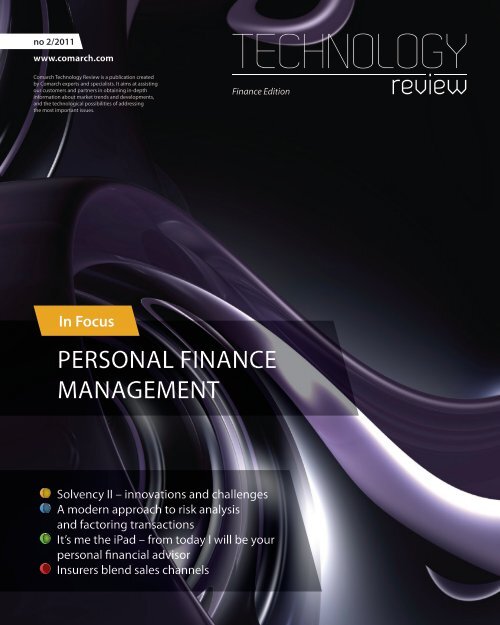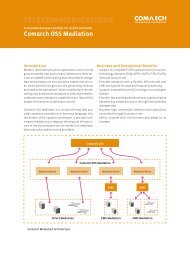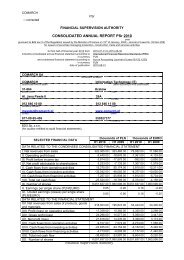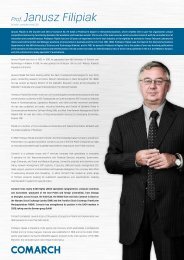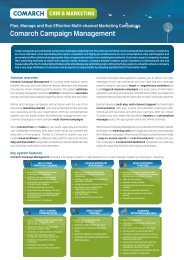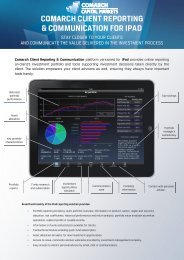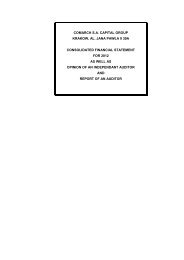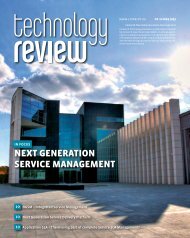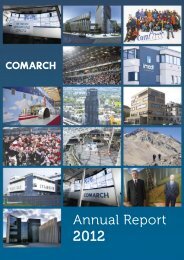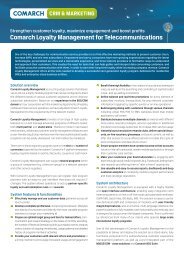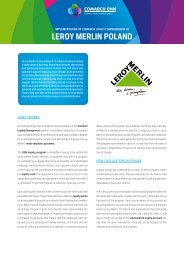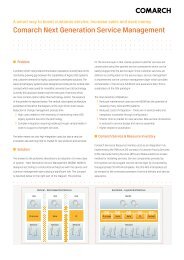PERSONAL FINANCE MANAGEMENT - Comarch
PERSONAL FINANCE MANAGEMENT - Comarch
PERSONAL FINANCE MANAGEMENT - Comarch
You also want an ePaper? Increase the reach of your titles
YUMPU automatically turns print PDFs into web optimized ePapers that Google loves.
NEWS 5<strong>Comarch</strong> automates the client reporting and communication in SKAGEN FundsSKAGEN Funds, a leading Norwegian funds management company, has decided to automate the client communication and reporting processes with <strong>Comarch</strong>Reporting Platform.The project aims to deliver the best-class reporting to individual and institutional clients inseveral countries owing to comprehensive internal reporting and analytical tools based onthe data warehouse technology and business intelligence. The communication within thecompany, as well as between advisors and clients will be provided through a reliable webportal accessed via different communication channels.The project takes advantage of <strong>Comarch</strong>’s unique long-term experience in business intelligence,data warehousing, performance and attribution analysis as well as building communicationplatforms. The comprehensive solution will be delivered in a secure and scalableSaaS model from one of <strong>Comarch</strong>’s Data Center locations in Europe.– Building long term relations with clients based on trust, transparency and communicationhas become the key challenge for the investment industry. In this project we will combine ourdeep domain knowledge of portfolio and performance reporting with the services infrastructureproviding flexible, scalable and reliable environment to meet SKAGEN’s business goals. We lookforward to another successful implementation due to strong commitment from both sides – saysGrzegorz Prosowicz, Business Development Manager at <strong>Comarch</strong> SA.– It is important for SKAGEN Funds to design and implement a bespoke reporting platformthat can best retell the unique SKAGEN story. We believe that in <strong>Comarch</strong>, we have found a strongand flexible IT partner for the entire project lifecycle – from custom design, implementation andoperations. This platform will help SKAGEN deliver on our client commitment to provide worldclasscommunication and service – underlines Jim Sumpter, who along with Bjørn Tjemsland,is the project manager for client reporting at SKAGEN Funds.The new NOL3 was launched at Alior Bank’s brokerage houseThe new NOL3 was launched at Alior Bank’s brokerage house. <strong>Comarch</strong>’s trading platform, enhanced with a new transaction module and new functionalities whichenable adapting to the ever-changing stock market situation, and the automation of investment strategies, is now available to Alior’s clients.<strong>Comarch</strong> NOL 3 is a fully developed application that enables real-time tracking of quotationsand trading of financial instruments listed on the stock exchange or other trading facilities.It also carries out analysis of current and past market trends, as well as creating individualinvestment strategies tailored to the investor profile. NOL3 is used by brokerage offices inPoland’s leading banks : BZ WBK (AIB Group), BPH (Ge Capital Group), Alior Bank (Carlo TassaraGroup) and Bank Ochrony Srodowiska.The newest version of NOL3, developed for Alior Bank’s clients, was enhanced with atransaction module which will satisfy the needs of beginner and experienced investors.We put great emphasis on functionality and ease of use, that’s why our customers don’thave to review specific parameters (i.e. portfolio and OTP condition) when placing orders.Functionalities such as an automatically updated tab containing all values within the brokerageaccount and price tracking, which enables automatic updates of the price limit onthe placed order, are also worth mentioning - says Wojciech Wyżga e-brokerage director atAlior Bank’s brokerage office.– We are currently working on further functionalities in NOL3, which have to do with thedemands of the Universal Trading Platform, the new trading system to be deployed on the WarsawStock Exchange in 2012 – says Grzegorz Prosowicz, Business Development Manager at<strong>Comarch</strong> SA. – <strong>Comarch</strong> Online Trading platform (NOL3) is the most up to date tool on thePolish market. NOL3 provides access to current exchange quotations and information, marketand value analyses, and enables carrying out typical Order Management System (OMS)tasks,such as placing orders straight from the exchange rates table and sending them to the marketat the appropriate time.<strong>Comarch</strong> revamps asset management in Aviva PTEImplementation of the <strong>Comarch</strong> Asset Management System in Aviva pTe (pension fund management company) Aviva BZ WBK SA has proved to be a success. AvivaPTE manages the second largest pension fund in Poland. It has more than 2.7 mln clients with an asset value of some PLN 53 bln.The new system limits the work entailed in the management of assets and automates manyprocesses connected with valuation and external reporting.As part of the project, <strong>Comarch</strong> implemented a complex solution which handles managementprocesses and asset valuation. The <strong>Comarch</strong> Asset Management system carriesout various activities connected with the handling of open pension funds as well as PTE’s,from asset management through transaction and settlements verification and introductionof other necessary operations, to a valuation of all assets. It also calculates the value ofa participation unit and generates obligatory reports, including daily files for the FinancialSupervision Commission (FSC).– The wide functionalities of <strong>Comarch</strong> Asset Management allow a complex automation ofthe client’s business processes and guarantee an ergonomic service. Among others, the systemmonitors and controls cash liquidity, and instances when investment limits are exceeded, in realtime – says <strong>Comarch</strong>’s project manager Marcin Toś. – <strong>Comarch</strong> Asset Management is a veryflexible tool, which can easily be adapted to client needs, as was done in the case of Aviva PTE.– The analysis and management process of the requirements essential for such a wide scopeof changes required particular effort and commitment from the project team – says, Aviva’s headproject analyst, Robert Pacoszka. – Additional limitations caused by implementation deadlinesposed a significant challenge. They required us to be disciplined and to approach the analyticalwork in a methodical manner.
NEWS 7<strong>Comarch</strong>’s solution in Raiffeisen Bank Polska’s brokerage houseRaiffeisen Bank Polska has signed a contract with <strong>Comarch</strong> to implement a complex system for handling brokerage house operations. The project covers the realizationof a central transactional-recording system as well as applications, which support the work of brokers and dealers in a headquarters as well as providing transactionalinternet tools for clients.The project covers the realization of a central transactional-recording system as well as applications,which support the work of brokers and dealers in a headquarters as well as providingtransactional internet tools for clients.– The modern brokerage system should allow the effective handling of individual and institutionalclients interested in operations on various markets, or in the use of specific transactionaland algorithmic tools that react quickly to new information as well as the non-effectiveness ofthe market – says Grzegorz Prosowicz, <strong>Comarch</strong> Business Development Manager responsiblefor capital markets. – The product we are entering the market with guarantees a high degreeof flexibility for the instruments and markets that it handles while at the same time fulfilling thegrowing requirements with regards to the order processing speed, increased data volumes as wellas openness in communication – Prosowicz adds.– The launch of Raiffeisen Bank Polska’s brokerage house does not only supplement the currentoffer for our clients. We also want to reach the most active individual investors and offer theminvestment perspectives that have been the standard for many years on mature capital markets.The realization of this project, together with <strong>Comarch</strong>, is mainly connected with new possibilitiesthat will be brought by the expected replacement of the Warsaw Stock Exchange transactionalsystem – says Jacek Wiśniewski, Investment Banking and Economic Analysis Director at RaiffeisenBank Polska.The <strong>Comarch</strong> Insurance Claims solution fully complies with Celent’sThe <strong>Comarch</strong> Insurance Claims solution fully complied with Celent’s requirements as far as business functionality, technical architecture and the number of referenceswere concerned. The system was awarded with a full profile in the European Claims Vendors in 2010 report.Celent examined 21 vendors but gave full reviews to only 10 systems deployed in Europe,which were endorsed by at least one reference. According to Celent, claims handling andmanagement is still very popular among European insurers. Effective claims handling, aswell as underwriting, are crucial to the success of the insurance business. The survey resultsconfirm the importance of claims handling in ensuring the satisfaction of insurers, whichleads to increased customer retention.<strong>Comarch</strong> Insurance Claims is a modern solution providing comprehensive support of alltypes of life insurance claims. The system helps to reduce the costs incurred in processingclaims by automating processes and eliminating most of the tasks based on paper documents.<strong>Comarch</strong> Insurance Claims offers a procedural approach to task realization owingto its high flexibility, scalability and complexity. <strong>Comarch</strong>’s offer also includes systems andmodules dedicated to handling property claims.Celent is a research and consulting company focused on the application of informationtechnology in the global financial services industry.The implementation of <strong>Comarch</strong>’s biometric mechanisms by Bank PEKAO SAThe implementation of <strong>Comarch</strong>’s biometric mechanisms by Bank Pekao SA has been a great success. Thanks to the implementation, users of the bank’s transactionalinternet platform can log into the system and authorize tasks using their fingerprints. The project uses <strong>Comarch</strong>’s new SmartCard Bio, which is fitted with biometricapplets, card and fingerprint readers integrated in one small device.The use of biometrics in electronic banking sees the fingerprint as an element, which guardsagainst access to the private key, which is stored on the cryptographic card (equivalent of thecard PIN). The fingerprint secures access to the whole content of the cryptographic card independentlyfrom the number of keys stored on the card. The user has three options which hemay choose from to access the private key: fingerprint ID, user PIN and a combination of thetwo. Any option, from those listed above, can be chosen using the internet banking system.– The use of cryptographic cards is a recommended solution because it is a reliable methodof authentication and authorization which uses the electronic signature. We have decided to linkour cryptographic cards with the biometric mechanism to make them easier to use by their owners.The user does not have to remember the card PIN as there is no need to enter it every timewhen logging into the system or authorizing a transaction. All the user needs to do is use his fingerwhich unblocks access to the card – Tomasz Sniezynski, <strong>Comarch</strong> IT Security ConsultingDirector, explains. – Our priority is to deliver easy to use solutions for every user’, Sniezynski adds.The biometric method of logging in and authorizing transactions used by Bank PekaoSA in their corporate banking internet service was accredited by the panel judges fromthe V Congress of e-Economy (Kongres Gospodarki Elektronicznej), in the competitionfor the project of the year. The aim of the competition’s organizers was to give merit toan institution or person whose activity helps to develop the electronic economy and ITsociety in Poland.– Modern transactional banking is chiefly based on innovations. We are always tryingto be a step ahead of the competition and to be the first to deliver the best, most modernand safest solutions to our Clients. We have decided to authorize tasks in the PekaoBIZNES24system using fingerprint ID readers. Thanks to the integrated <strong>Comarch</strong> SmartCard Bio, BankPekao SA clients are the first in Poland to use a biometric method of logging in and authorizinginternet banking transactions for corporations – Piotr Dusza, Bank Pekao SA E-ChannelsDirector, underlines.
8 News NEWS In FocusReporting & Communicationfor iPadStay closer to your clients and communicatethe value delivered in the investment process<strong>Comarch</strong> Client Reporting & Communication platform versioned for iPad provides regular reporting onclient’s investment portfolio and tools supporting investment decisions taken directly by the client. Thesolution empowers your client advisors as well, ensuring they always have important tools handy.HistoricalportfolioperformanceTopholdingsAssetallocationKey portfoliocharacteristicsPortfoliomanager’scommentaryPortfolioreportsFunds researchand subscriptionInvestmentopportunitiessimulatorCommunicationzoneCompanyinformationContact withpersonal advisorBroad functionality of the iPad reporting solution provides:»»Portfolio reporting including: quick portfolio overview, information on product,sector, region and currency allocation, risk coefficients, historical performanceand return analysis, portfolio value evolution as well as operations, realized profitsor taxable income.»»Information on funds and products available for clients.»»Transactional module enabling quick fund subscription.»»Asset allocation simulator for new investment opportunities.»»Access to news, comments and live webcasts provided by investment managementcompany.»»Easy access to client’s personal advisor by email, chat or communicators.
in NEWS Focus9Mobile reporting once recognized to support client service is a powerful tool to differentiateover competitors. Providing reliable and up-to-date information on portfolioperformance and risk helps to build trust and increase client satisfaction and loyalty.<strong>Comarch</strong> combines knowledge of investment managementbusiness and processes with expertise in numerous technologies.This enables us to optimize our customers’ processes efficiently,reduce their business costs, and increase their incomesby allowing them to enter new market areas and customersegments. <strong>Comarch</strong> not only helps you bring your visions andideas to life. We actively participate in the process of optimizingyour processes and operations in order to make sure thenewest mobile technologies give your business the right boost.Having successfully completed more than a hundredmobile-related projects in various sectors, <strong>Comarch</strong> has gaineda lot of expertise. This expertise is being constantly improvedand applied to our products and competence centers, as westrive to deliver the best solutions for specified business cases.<strong>Comarch</strong> offers you business mobile solutions and servicesthat consist of:»»High-level business and technology consultancy»»Business case development»»Software prototyping and proof of concept»»Usability design»»System integration and master data management»»Quality assurance and testing»»Global service level Agreement and maintenance services.Grzegorz Prosowicz<strong>Comarch</strong> SAE-mail: Grzegorz.Prosowicz@comarch.comPosition: Business Development ManagerSector: Financial Services
12 In Focus<strong>Comarch</strong> Exchange Trading<strong>Comarch</strong> eXchange Trading is a new product on offerfrom <strong>Comarch</strong>. We are speaking with Artur Krzystek,Business Unit Manager at <strong>Comarch</strong>, who is responsiblefor the product’s creation and implementation.
in Focus13Why is <strong>Comarch</strong> designing a new brokerage system?Artur Krzystek: This is a good moment for the creation ofa new system in the brokerage sector. A new transactionalsystem will be implemented on the Warsaw Stock Exchange(WSE) from 2012. The current WARSET will be replaced bysoftware belonging to the WSE’s new partner – NYSE-Euronext.This is a chance to break up the dual monopoly of twosuppliers on the Polish market. <strong>Comarch</strong> has undertaken thischallenge and is actively working on an innovative solution.We have employed people from the financial market with alot of experience in brokerage offices. Thanks to their knowledgeand <strong>Comarch</strong>’s openness to the newest technologies,we are certain, that our clients will receive the best transactionalsystem in Poland. Apart from changes in the technologyused by the WSE, we are motivated by other factors. Weexpect that the Warsaw bourse will attract ever larger companiesand Stock Exchange players. Brokerage offices deservethe implementation of a system which will carry the immenseliquidity present on the securities market, allow fast tradingwhile at the same time being user friendly.How does <strong>Comarch</strong>’s system differ from other solutionsavailable on the market?Artur Krzystek: We are placing out bets on a ‘system for people,’which is one that accepts the superiority of brokers anddealers over accounting operations. The application is gearedtoward serving players as a tool for the efficient execution ofmarket operations, which does not make their actions dependenton technological limitations or formalities connectedwith the registry side of the transactions. Thanks to the design,which is based on highly efficient grid solutions, we are able toguarantee a high system capacity (processing increased datavolumes), servicing orders at a speed not heard of until now(especially important with high-frequency trading), as wellas reliability and security. R&D research carried out as part ofproject development has reduced the time it takes to serviceorders twofold, compared to the competition. What is important;we are ‘opening’ our system to other solutions through awidely available interface. It will allow external users and softwaresuppliers to access the application via a standardized API,including FIX protocol. This will be the first fully open tradingplatform delivered by Polish suppliers.What will the brokerage office gain from implementing<strong>Comarch</strong> eXchange Trading?Artur Krzystek: As I mentioned earlier, the brokerage officewill get a system that is in accord with the new technologypresent on the WSE. It will be faster, more flexible and userfriendly. It will allow the user to ‘play the game’ effectively, thususing algorithms to trade on the cash and derivatives market.A definite advantage of our system is the possibility to configureprocesses by business administrators. This occurs as part ofthe workflows (e.g. verifying algorithms or freeing tasks), as wellas long-term processes, such as client services. In most casesit eliminates the need to carry out software work on the supplierside. The system not only has a rich functionality, but wealso take care to have the best usability. A stock market playeris a very demanding person when it comes to the speed ofthe application. The artistry lies in creating software which willguarantee the full operational possibilities, and using it will bea pleasure. We invite you to get to know the system that willfulfill these tasks – <strong>Comarch</strong> eXchange Trading.I understand that the system is flexible enough to beadapted to international markets and can be used byforeign brokerage offices?Artur Krzystek: We designed the brokerage system for companiesfrom different countries that want to handle stockexchanges all over the world. The application allows tradingon many markets (e.g . WSE, Forex, TGE, Frankfurt) under oneaccount, using various types of financial instruments (e.g.securities, derivatives, currency etc.). A Polish market traderusually owns a few accounts – a cash account and accountsthat handle transactions on foreign stock exchanges. <strong>Comarch</strong>eXchange Trading aggregates different operations on oneaccount. It has a flexible construction, thanks to which it canprocess various account plans and calculation formats withdifferent depositary banks. The system also handles multi currencyoperations and its interface can of course be configuredin any language.When can we expect the first system implementations?Artur Krzystek: Implementations will be carried out in Polandbut the product will also be on offer beyond its borders. Thefirst implementation is taking place in the Raiffeisen Bank Polskabrokerage office. The company wants to reach out to themost active individual investors and offer them investmentperspectives, available on mature capital markets. There is a lotof interest in <strong>Comarch</strong> eXchange Trading but it is too early toreveal who else will benefit from the competitive advantagethat the <strong>Comarch</strong> system offers.Interview by Grzegorz PękałaArtur Krzystek<strong>Comarch</strong> SAE-mail: Artur.Krzystek@comarch.comPosition: Business Unit ManagerSector: Financial ServicesGrzegorz Pękała<strong>Comarch</strong> SAE-mail: Grzegorz.Pekala@comarch.comPosition: Marketing specialistSector: Financial Services
14 In Focus<strong>Comarch</strong> is a dependable partnerin Wealth Management<strong>Comarch</strong> is reacting to progress in capital management and privatebanking services by offering new dedicated wealth management andprivate banking systems. Grzegorz Prosowicz, Business DevelopmentManager at <strong>Comarch</strong>, tells us about the power of applicationsand <strong>Comarch</strong>’s plans for further development in this sector.
In in Focus15Wealth management and investment consulting haverecently become popular concepts. Where does theirpopularity stem from?Grzegorz Prosowicz: Let’s start from the beginning. Wealthmanagement, a service previously unavailable on the Polishmarket, is now becoming a crucial part of the financial institutions’offer. This concerns banks, as well as investment consultingcompanies catering to individual clients. Increased interestin wealth management solutions can be attributed both to targetgroup growth and a change in the approach to customerrelationship management on the part of financial institutions.The latter became necessary as a result of the recent financialcrisis which undermined customer trust in institutions, whichoffer investment products, and caused a certain ‘oversensitivity’to market information among investors.This is where the need for a new model that caters forwealthy clients – based on their needs, goals and education –comes from. Focusing on selling products is not enough anymore.Financial institutions are beginning to see that retainingcustomers by building long-term relationships founded ontrust is just as important as bringing in ‘new business’.What are capital management services?Grzegorz Prosowicz: Wealth management is the preservationof its real value and the provision of opportunities foradditional profit, while taking into account the customers’goals: planned expenses, loss prevention or retaining liquidityof the portfolio to allow withdrawing funds in unpredictablecircumstances. In a broader sense, wealth managementservices include tax optimization and managing customerassets, for example real estate.How does <strong>Comarch</strong> Wealth Management supportcompanies offering these products?Grzegorz Prosowicz: <strong>Comarch</strong>’s Wealth Management andPrivate Banking solutions offer a complete customer serviceranging from customer relationship management andinvestment consulting (analyzing customer profiles, choosingstrategies and products, simulating various scenarios, optimizingportfolios) to monitoring customers’ goals and portfoliochanges. <strong>Comarch</strong>’s offer includes a dedicated portal forcommunicating with clients, portfolio reporting services andsupport for mobile devices for both consultants and customers.The latter is a significant enhancement of the financialinstitutions’ offer, which follows new trends in customer relationsand communication.What are the benefits of deploying <strong>Comarch</strong>’s system?Grzegorz Prosowicz: <strong>Comarch</strong> is a dependable partner, whichsignificantly limits project risk and opens up a path for furtherdevelopment. <strong>Comarch</strong> provides access to the newest technologiesand the system architecture guarantees scalability:its open to future enhancements with new modules respondingto business growth and new needs. <strong>Comarch</strong> offers muchmore: experience and a long history of cooperation with bankingand financial institutions, reliable data models for wealthmanagement services, first class analytical tools and reportcomponents based on the industry’s best practices.Interview by Grzegorz PękałaSee more at:www.assetmanagement.comarch.comGrzegorz Prosowicz<strong>Comarch</strong> SAE-mail: Grzegorz.Prosowicz@comarch.comPosition: Business Development ManagerSector: Financial Services
16 In FocusNew dimension in bankingPersonal Finance ManagementBanks looking to become thir clients’ main financial partnerturn to an innovative solution, the PFM. What’s in it for theBanks? What’s in it for the clients? Tomasz Drożdż explores thebenefits of personal finance management applications.
in Focus17How to become a client’s main financialpartner?What does a bank know about its clients? The most active clientshave accounts in many different banks. Their transactionhistories show that they tend to have cash expenditures andinvestments that they handle using other financial institutions.A single bank often possesses only a snippet of informationabout a client’s finances, and in this situation it is difficult tochoose the right moment to offer the client a product package.A bank, which wants to become the client’s main financialpartner, should make sure that a person who is planning toacquire a car, receives an offer for a car loan, someone whoseaccount balance remains the same every month, be given anoffer for systematic investment and someone who reservesair tickets – an insurance offer or a card which allows them totake money out abroad. What is the best way for a bank to getto know a client’s financial plans?The place where the needs of the client and the bank convergeis PFM, an electronic banking module that helps clientsmanage their personal budget. PFM guarantees banks accessto important information about a client’s financial plans, permanentobligations and products which they own in otherfinancial institutions. At the same time it constitutes a modernand very successful sales channel.How does PFM generate profit?Recently published research shows that 61% of Poles plan theirdomestic budget and 93% would like to better manage theirfinances. Such a need is most probably exhibited by people whoown many different financial products which require monitoring(accounts, cards, deposits, various investment types etc).PFM, which supports the management of personal finance,fulfills these needs.The system groups information about a client’s financialmeans, permanent obligations and future financial plans.In practice it can function as a ‘bookmark’ in the electronicbanking system, or as a separate module accessible on thee-banking level. PFM provides the user with information abouttheir current financial situation, structure of expenditures andrevenues, and helps to plan their financial future in the shortand long term. Despite its advanced functions, a correctlydesigned PFM is simple and pleasurable to use: the analysesthat it delivers are presented in the form of readable, colorfulcharts and balance sheets. Figuring out the use of individualtools is intuitive.The last five years have seen a rise in the global popularityof PFM. Systems of this type are already operational in manywestern banks. Their introduction to a bank’s system also usuallyturns out to be a great success. According to brand magazineThe American Banker, when Bank of America introducedPFM it noted a 700% increase in the activity of its electronicbanking sector. How is this possible?Clients who use PFM quickly notice that it is cash transactionsthat most often defy analysis, this causes their motivationto use cards and transfers to increase. Thanks to the simplicityof loading transaction data from a client’s main bank to PFM,clients are gradually starting to conduct transactions, usuallycarried out with competing banks, using the bank providingthe PFM. Transactions from other banks can only be carriedout in the system manually. Using PFM, clients become familiarwith a bank offer that is automatically adapted to their currentneeds and as a result they use it more often. The advantages ofPFM have also been noticed in Poland. It functions in the banksCiti Handlowy and Meritum. A PFM implementation, which isbeing realized by iFIN24 SA, is currently being carried out in aleading Polish bank.Tomasz DrożdżiFIN24 SAE-mail: Tomasz.Drozdz@ifin24.plPosition: Business Solution ManagerSector: Financial ServicesUser Panel finanse.iFIN24.plHow does PFM work?> PFM automatically categorizes transactionsthanks to which the user (and the bank)become familiar with the structure of his/herexpenditures.> The system calculates a monthly budgetlinking the realized and planned revenueswith expenditures. This allows the user toforesee what part of the revenue he/shecan invest.> PFM allows the planning of futurespending, e.g. vacations or family celebrations.Based on this knowledge itis easier to make a decision on whatsize loan to take out or how highrepayment installments should be.> PFM is the ideal place to present apersonalized product offer.
18 In FocusPFM implementation advantages:> Access to valuable data: the client’s completefinancial situation as well as products ownedin other banks.> New sales channel with increased effectiveness– banking products are presented inaccord with the client’s profile and needs.> Encourages clients to move their operationsto a bank that facilitates theiranalysis.> The application answers to clientneeds –according to the latestresearch, 93% of Poles would like tobetter manage their finances and61% of Polish respondents plantheir domestic budgets.User Panel finance.iFIN24.plPFM in actionThe PFM module offered to banks by iFIN24 SA is a complete,readymade solution which can be integrated with any electronicbanking system, adapting it to the needs of the bank.iFIN24 PFM has been available for over a year as an independentInternet service.“Thanks to cooperation with service users we know theirneeds: we know what functions they expect and what theyuse most often. Users include clients from nearly all the retailbanks active on the Polish market ,“ says Wawrzyniec Sosnowski,deputy CEO at iFIN24 SA.Comments made by users have helped to refine the application.This has led to the introduction of a mobile version of theapplication designated for the iPhone, a version for the Androidsystem is also currently in the works. PFM iFIN24 mobile complimentsthe WWW service. It is geared towards a speedy registrationof cash expenditures and plans. The application alsoallows a preview of the current state of finance and reports.A quick synchronization of data with the WWW applicationoccurs in accord with the user’s wishes.“PFM users are people who freely use the Internet andmobile devices. They are open to innovations, usually haveabove average revenues and expect a high level of service“Sosnowski adds. “These are the users who are the most valuableclient group for banks, that is why we predict that PFMwill soon become a standard in banking, as access to accountsvia the Internet became before it.”
personal finance managementmodule for electronicbanking systemsPFM(Personal Finance Management)is an application which lets bankcustomers browse their balancesand automatically categorizedtransactions, and analyze thecondition of all their financial assets.PFM is not only a new and effectivesales channel, but also a sourceof valuable information for thebank, including the customers’financial plans for the future andproducts they own in other financialinstitutions.iFIN24 PFM is a complete workingproduct which can be customizedand integrated with any electronicbanking system.Demo versionhttps://finanse.ifin24.pl/demo-enGrand Duchy of Luxembourg <strong>Comarch</strong> Luxembourg S.a.R.L. Route d’Arlon 23 L-8008 StrassenPhone. + 352 271 168 18, + 352 271 168 19 e-mail: luxembourg@comarch.com
22 Trends & StrategiesInsurance industry is developing and matchingits actions to market realities. The appearanceof the Internet has given a new chance for thewide presentation of the offer and easier clientaccess. The conservative nature of insurershas been noticed in the careful approach toadapting the new medium. However, afterinitially carefully eyeing the Internet, it quitequickly began to use new opportunities.What can the agent do over the Internet?»»gain information about insurance products,conditions and rates, current promotions andmarketing campaigns»»use sales leads accessible as part of thecampaign with a goal to contacting potentialclients»»carry out a policy calculation; calculating the pricefor the insurance offered to the client depending onits scope and options»»register an application with client data and prepare(using the calculation mentioned above) an offer for theclient»»change the offer into a policy if the client accepts theconditions and makes the correct paymentour market price still consists a deciding factor withregard to the choice of insurance offer by the client,however, the trust given to the agent by clientsis also important and influences the maintenance ofthe agent’s role in sales. Insurance contracts are most oftensigned in Poland by agents. They make up 62% of the market.Agents are connected with insurance companies throughcooperation contracts and represent the insurer during clientcontact. Insurance brokers play a similar role to agents. However,they are not bound by contracts with insurers and carryout tasks for their clients. They look for the best offers and helpin choosing the right policy.»»become familiar with information about the state of his/herown portfolio, that is information about own clients, their policy,the state of repayments, submitted issues, and finally informationabout upcoming policy renewals»»look through their own sales dataA good insurance intermediary, agent or broker, builds up theirown client database for years. He/she is often recommendedto further clients by those who are happy with his/her services.An experienced insurance sales person gives advice and persuadestheir client to accept the best option. The CRM approachsprings to mind here. The role of CRM systems in this channelwas played for many years by agent books. These containedinformation about clients, installment deadlines andpolicy renewals. The process of bringing insurancecompanies into the age of IT has continued formany years. Many of them, especially the largerones, use applications that support sales andregister signed contracts.»»look through and accept (or not) commissions invoices that present theright payments»»up their qualifications through online trainingSome of the insurance companies activelysupport representatives of their own salesnetworks in these activities. A new directionthat has been taken is making serviceportals available to agents. Theseportals are developed internet platformswhich transfer the task of registeringdata onto agents, but givethem access to full client informationand quick underwriting support.The full back-office operations(updating new functionalities, maintenance, archivingetc) are the insurance company work. Thanks to this, the agent– even after changing the computer – has constant accessto their client database, without the need of reinstalling theright software. Simply speaking, we can call this model a ‘privatecloud’ managed by the insurance company, which makessales tools accessible as a service.How does direct insurance work?Some insurance companies decided to enter the market viathe Internet and telephone. This new and different channelhas been named ‘direct insurance.’Insurance companies that are active in the direct model basetheir activity on client contact via the telephone (companiesown a contact center or use external services of this type) aswell as the Internet. Sales are the result of gaining telephonecontact with the client who supplies his data during a conversationwith the advisor. Based on this, the IT system calculatesthe price and passes on additional insurance conditions.The first telephone conversation, during which most of thedata is registered, is often the longest. Data gathered in previousyears is used for renewing the policy. Signing a contractthrough the internet runs in a similar way. In this case the clientdoes not phone the contact center, but independentlyenters the required data in internet forms that are especiallyprepared for this on the insurer’s website. The appearance ofdirect insurance has also brought the promise of lower policyprices, which could be decreased by the size of the commissionthat was previously paid to the agent.The first insurance, available on the Internet, was offered inPoland by a company called Hestia in 1997. The full direct insurancebusiness model appeared on our market in January 2003,when Link4 launched insurance policy sales. In the followingyears more direct insurance companies entered the market.From the moment that it was available the new sales chan-
Trends & Strategies23Direct is an insurance sales model that assumesdirect (without an intermediary involvement)contact of the insurer with the client.It is narrowly understood and identified withinsurance sales via the telephone and Internet.nel became the subject of hot and stormy discussions heldby many analysts. Some were convinced from the beginningabout the imminent and huge success of direct insurance andof a fall in the significance of the traditional insurance salesmodel. These expectations were based on the example of theUK market were more than 60% of motor insurance was madeusing direct insurance. Meanwhile the years went by, directinsurance in Poland stabilized and became an important elementof the market. The sales of policies via the Internet andtelephone reached 3% of the whole market in Poland (databased on 2009 results, before the announcement of the fullstats in 2010).The assertion that direct insurance was not successful in Polandis premature. This sales channel is constantly maturing andprimarily constitutes an important alternative for the growingclient group that does not only pay attention to price, butalso to a comfortable method of access to the offer. Entry ofdirect insurance onto the market has significantly influencedmarket, which was previously regarded as traditional. Companieshave been forced to react. It not only caused a pricewar, which affected non-life insurer results significantly, butthe traditional players had to offer their products in the newchannels to stay competitive and provide modern customerexperience to their clients. New sales channels turned out tobe important for companies which up till now solely usedthe traditional sales model. These companies are now notonly opening up to young Internet users, but also to all thosewho could gear their attention to a competing offer availablevia direct insurance. An insurance client looks for comfortand a modern approach not only in the offer, but also inthe method of access to it.Direct searches for intermediariesIn the final months of 2010 we witnessed another change inthe insurance business model. This time it touched the largestdirect companies, which had underlined from the verybeginning that they had a different approach tosales, and who built their brand on the resignationof services by insurance intermediaries, that arenow starting to cooperate with them. In the face ofa smaller than expected sale increase, market conditions haveforced direct companies to search for clients using traditionalchannels. Today, direct companies are looking for multi-agentnetworks and financial advisors, they are signing deals withcar dealers and dealerships. In a word, as one market commentatorsaid: “Direct insurers have now come down to Earth,”and have switched to the traditional sales model. Everythingis done in order to reach a larger client group. Examples ofthis phenomenon include a contract signed by Liberty Directwith car dealerships insurance intermediary Link4’s cooperationwith financial consultant Unilink and other contractsblending direct and traditional channels today.Recent events show an important trend in insurance sales. Onthe one hand we are seeing an increase in the importance ofIT support for traditional sales structures and an increasing roleof the Internet (as well as the internal company extranet) aswell as the tools based on it. On the other, it seemsthat after a few years on the market direct insuranceoperators have been forced to invest in traditionalsales networks. With this, the divisionsbetween the traditional insurance sales modelMariusz Janczewski<strong>Comarch</strong> SAE-mail: Mariusz.Janczewski@comarch.comPosition: Busines Development ManagerSector: Financial Servicesand the direct model are beginning to disappear,many market representatives testify toWhat does direct insurance offer clientsvia the Internet?this. This is decided on the one hand byclient habits and on the other due to an » access to the insurance company’s informationeasier access to specialist IT tools. Withportal, which gives access to the freshest and mostthis method both models have comeimportant information, current info on products,closer together. In the near futuregeneral conditions of insurance, promotions, individualthe insurance market will representchecking of offersa mixed sales model as companies » policy calculation and guarantee, policy simulation,will continue to develop multichannelforms of communica-» making an immediate payment, thanks to e-payment andproposal, submittal and insurance acquisitiontion and cooperation with clientsas well as intermediaries. » policy printing and SMS confirmationcapacity to handle cards» carrying out operations on policies – through access toinsurance data and the possibility of modifying basic client dataas well as submittals for changes in the scope of insurance coverand other important contract parameters» file a claim online
24 Trends & StrategiesConference participationFinancial Services SectorTendencies in marketing strategy are currently not undergoingsignificant change. Despite the recent economic crisis, companies areallocating a large chunk of their marketing budgets to participationin conferences. This is still one of the most effective methods ofpromoting the company and establishing business contacts.
Trends & Strategies25CONFERENCESare the idealplaces forbusiness development – they are a means of direct communicationbetween our sales team and potential clients.Meetings and discussions, building of mutual relations,gaining trust, as well as information exchange, constitutea good introduction to joint business dealings. However,conferences do not only serve the purpose of gainingnew clients. They are a unique means of information exchange,widening of knowledge, verifying market trendsas well as allowing the perfect platform from which topresent the company.According to market analysis carried out by the ContentMarketing Institute: B2B Content Marketing: 2010 BenChMarks,Budgets and Trends, nine out of ten organizations use the eightmain marketing tactics. The most popular tactic used is socialmedia (not including blogs) (79%), followed by articles (78%),participation in conferences (62%) and newsletters (61%). 1Fig. 1. Content marketing usage (by TACTIC)Tendencies in marketing strategy are currently not undergoingsignificant change. Despite the recent economic crisis, companiesare allocating a large chunk of their marketing budgetsto participation in conferences. This is still one of the mosteffective methods of promoting the company and establishingbusiness contacts.In 2010, <strong>Comarch</strong>’s specialists actively took part in conferences,seminars as well as national and international symposiums. Altogetherwe took part in 34 happenings, from which 25 were foreignconferences that took place in Europe – mostly in the DACHstates (Germany, Austria, Switzerland), Benelux and Scandinavia.Nearly half of the conferences, in which <strong>Comarch</strong> took part,on the Polish market were insurance sector events. We also participatedin a few conferences on banking and capital markets.Abroad, we took part mostly in banking and capital market events,whereas our participation was lesser in the insurance, factoringand finance sectors.Opinions given by participants about the content of Polishconferences were positive. Lectures, presentations and discussionswere carried out on a high level. There were few reservationsabout organizational issues. The only criticism can perhapsbe the fact of a smaller attendance than in previous years. Ourdelegates decidedly recommend taking part in most conferences,which they attended in 2010, as they present a perfectopportunity to meet people and to exchange know-how withcompanies and experts.Foreign conferences were also praised in terms of their content.In most cases a high level of speakers was noted, who presentedcurrent problems and trends in an interesting manner as well assharing their views on best practices. Our representatives werenot pleased with the level presented by speakers on only threeoccasions. The rating of the organizational aspect was diverse.Those that boasted the best organization sometimes failed to fulfillexpectations in terms of the possibility to meet potential clients.In 2010 we seldom took part in conferences as experts-speakers.However, Sławomir Wójcik, <strong>Comarch</strong> Solutions Manager, dida presentation entitled Building long-term client relations – toolswhich support investment consulting as well as reporting on theclient portfolio effectiveness and risk in Poland, at the Forum forAsset Management. <strong>Comarch</strong> also sent speakers to two foreignconferences: Sławomir Gierek, Consulting Director, spoke aboutThe Future Branch of Corporate Banking at a Corporate Bankingconference and Marcin Stefańczyk, Consulting Director, spokeabout IT Tools in Shaping Credit Risk Management – Value of ITSystems in Minimizing Risk at a conference on CEE Credit RiskManagement.Unfortunately there is no consensus in opinions about thequality of Polish or foreign conferences. Most of the time, internationalorganizers get good ratings but they are sometimescriticized due to an unsatisfactory number of potential clientsat the conference, which then leads to weaker chances for networking.Similar remarks are made with regards to small andlocal organizers.Descriptions of conferences in which <strong>Comarch</strong> participated in2010 can be found at www.finance.comarch.com.In 2011, as in previous years, we will actively take part in conferences,symposiums and other events for companies from thefinancial sector. Similarly to 2010, the majority of events in whichwe want to take part will take place in Western Europe.Izabela Wieczorek<strong>Comarch</strong> SAE-mail: Izabela.Wieczorek@comarch.comPosition: Marketing SpecialistSector: Financial Services1http://www.contentmarketinginstitute.com/wp-content/uploads/2010/09/B2B_Trends_2010.pdf
26 Trends & StrategiesOur solutionsSOA– architecture oriented toward developmentThe <strong>Comarch</strong> SOA Platform is a solution which implements architecture oriented toward services(SOA – Service Oriented Architecture). It allows the integration of various IT systems and simplifiedmanagement of the whole architecture. Adrian Hajduk, the consultant responsible for implementingthe <strong>Comarch</strong> SOA Platform in financial institutions, answers questions about the ESB.A situation which often occurs in IT sectors ofbanks is where a change in one system forceschanges in other applications, part of the functionsstop working and they have to be mended.Does making changes in financial institutionsreally have to be so complicated?Adrian Hajduk: Problems connected with compatibilitybetween systems mount up as new programs andapplications are added. The number of protocols thatneed to be handled is increasing. With this, the needto integrate new systems with already existing ones isappearing in large organizations. Clients often resign
Trends & Strategies27to design systems that are based solely on standards, which areused by many companies. Unfortunately every company hasits own communication methods which are usually not compatiblewith the competition’s software. There is space herefor using SOA architecture which allows for the integration ofvarious systems using services which fulfill defined businessfunctions. The services that the ESB offers are visible for systemswhich exchange data between one another with its help.Who and why should think about implementing theSOA architecture?Adrian Hajduk: Companies that own systems which communicatewith each other should think about implementing SOAarchitecture. Systems which communicate with each other withoutthe use of the ESB often use spaghetti-type connections.It is not only difficult to manage them, but at a certain pointthe IT sector loses control over which system sends messagesto which. Problems also come up in integrating new applicationsinto the system. If the client owns a SOA solution, thenall that is required is the adding of new services to the systemor, if there is such a possibility, using existing ones.What are the advantages of implementing the<strong>Comarch</strong> SOA Platform for the IT sector and whatare they for the business sector of the financial institutionin question?Adrian Hajduk: When deciding to use the <strong>Comarch</strong> SOAsolution the IT sector gains greater control over communicationsbetween systems, as well as the possibility of easier integrationwith new applications. Additionally, thanks to the useof such elements of the platform as the SOA Registry or SOASupervisor, it can catalogue and test services, manage queuesor control the SLA. The business sector gains the possibility toimplement new solutions at a lower cost as well as the certaintythat the services will realize set business functions. It isworth remembering that a good service is one which allowsthe user to find out exactly what it is doing without the needfor extra IT knowledge. For example, the user knows what theservice “pay funds onto the account” is for.implementation. Reports are made duringthe analysis stage, thanks to whichthe most important business processesfor the client are defined. The documentdescribes the existing applications andtechnologies used to create them. Itallows the user to become familiar withthe data model being used. A canonicaldata model as well as a mapping anddata transformation process based on thisdata model. The process of integration followsthe analysis phase which starts withthe most important system. This systemis moved to the ESB first, less importantsystems follow.Which companies have used the<strong>Comarch</strong> solution? Who can benext?Adrian Hajduk: In most cases the solutionis used by financial institutions.Clients who may be interested in the<strong>Comarch</strong> SOA Platform are thereforebanks, insurance companies, capital marketcompanies and service industry companiesor telecoms firms which own a fewsystems, that have to communicate witheach other. Companies thinking aboutimplementing a few new systems in thefuture should also think about its integration;the costs of integrating each systemseparately will most definitely be alot higher.Interview by Grzegorz Pękałafrom implementing a new system due to the problem of integration.Even if the implementation of a new solution is justified,the costs of its integration with the remaining systems can belarger than the forecasted profits. An ideal solution would beHow does <strong>Comarch</strong>’s proposal stand out compared toother products available on the market?Adrian Hajduk: <strong>Comarch</strong>’s solution is a complete platformwhich not only consists of software but also includes businessand systems analysis as well as integration. Additionally,every implementation is characterized by an individual clientapproach and division into phases. During the implementationthe client has control over the whole process. Clients ownsystems which can integrate themselves with other systemsusing various methods. If the company acquires a ready-madesolution with imposed methods of integration, then it has alimited possibility of influencing the method of integration.Lets return to the implementation. It usually has amulti-phase course. What exactly does this look like?Adrian Hajduk: Every implementation is made up of a fewphases, including analysis and the correct process of systemAdrian Hajduk<strong>Comarch</strong> SAE-mail: Adrian.Hajduk@comarch.comPosition: Business Solutions ManagerSector: Financial Services
28 Trends & StrategiesOur solutionsMobileApplicationsSecurityTechnological development and the availability of mobile deviceshave provided the possibility to create advanced mobile applicationswhose functionalities equal dedicated applications for PCs. Thissituation forces mobile software providers to ensure adequatesecurity mechanisms tailored to specific threats for mobile devices.During the design stage, attention should be paid to aligningsecurity to the required level of protection while maintaining highergonomics and mobility of applications. A good design practice,which helps balance the safety and usability of the application isto extract the critical functionality and adapt the securer’s methodof securing to the relevance of the protected information.MOBILEdevices are especially exposedto the loss of confidentialdata due to larceny or loss. The mobility of devices determinestheir growing popularity and fast development,on the other hand mobility is a serious threat to the securityof data stored on the device, which is transmittedbetween the application and the server. Communicationsecurity can be ensured by encrypting the transmissiondate using the HTTPS protocol (SSL/TLS) supported bythe all the most popular mobile platforms. The securestorage of data on the device is a big challenge for applicationdevelopers. The method and strength of datasecurity depends on the system platform and additionaltools used to protect sensitive data. Protection againstunauthorized access can be realized by encryptingthe data using a secret key (for example, AES-256). Thestrength of this solution is based on securing access tothe key. In this case the first line of defense may consistof the so called ‘secure store’ mechanisms, which areavailable in the system platform. The mechanisms enableprotection of sensitive data against access fromother applications, e.g. J2ME RMS (Record ManagementSystem) or the iPhone keychain. Each system platformprovides its own security model, which primarily guaranteesthe separation of data and processes of one applicationfrom another, as well as dividing the necessaryruntime environment, limited solely to the functionalityof the operating system, whose application requiresproper functioning.The second method to secure the secret key is anadditional device in the form of a cryptographic card.There are three solutions based on the functionality of
Trends & Strategies29Tomasz Poręba<strong>Comarch</strong> SAE-mail: Tomasz.Poręba@comarch.comPosition: Business Solutions ManagerSector: Financial Servicesthe cryptographic card, used in the context of the security ofmobile devices:»»SIM card with cryptographic coprocessor»»Cryptographic microSD card»»Cryptographic card with reader, which could connect withthe mobile device via Bluetooth.All these solutions guarantee the physical protection of the key(access granted via a PIN) irrespective of the technology used.This method allows a two-factor authentication based on whatuser knows and what the user has. The additional advantageof these solutions is the possibility use the mobile electronicsignature, e.g. in mobile banking (authentication and authorizationof transactions), administration (communication with theoffice) and other applications (mobile VPN channels). Thanksto the use of the native application (applications dedicated fora specific system platform) it is possible to utilize mobile signaturetechnology and many other strong authentication andauthorization methods.These applications, as opposed to web applications, allowfull use of the technical possibilities offered by the device.This translates into an increased possibility of applicationfunctionality and guarantees a higher level of security. A goodexample of the potential of native applications is the built-inapp, which generates one-off passwords (including in thechallenge-response mode). It responds to threats of transactiondata conversion by hackers in internet banking. Thanks touse the WYSIWYA (What You See Is What You Authorize), theuser can see the transaction data which he/she authorizes.Additionally, the application is secured by a user PIN; in this casewe also deal with a two-factor authorization method. Thanks tothe integration of this authorization method with the dedicatednative application (e.g. mobile banking),we achieve a high level of security andergonomics, functionalities, and mobilityof the whole solution. Another argument,which reinforces the advantage of usingnative applications, is the ability to verifythe software developer thanks to theapplications being signed and makingthem accessible only in dedicatedapplications stores. For some platforms(iPhone, Windows Mobile), the registrationand application verification process hasto be completed before the application ismade available. This additionally increasesthe security level and protects the useragainst improper functioning of theapplication. When analyzing the securityof mobile applications we should payspecial attention to regularly updatingthe operating system. Observance of therecommendations protects the user froma potential hacker who could take controlthrough exploiting system vulnerabilitiesand gaps.<strong>Comarch</strong> prepares its own mobilesolutions based on its experience andknowledge gained during its activitieson international markets, and supportedmany years of R&D experience. The solutionsoffer a wide range of functionalitiesand also give a high level of securityadapted to the specifics of the application,process information, potential dangerousand new attacks.
30 Trends & StrategiesHardware trendsIt’s me, the iPad– from today I will be yourpersonal financial advisor2011 is set to be a break-through year. Such talk is heard often,especially at the start of a new year when we hope that the positivechanges that we are expecting will come about. This time weare thinking of very concrete and serious expectations in an areawhich wouldn’t have been taken into account at all, if it wasn’tfor the modern devices that appeared on the market in 2010.
Trends & Strategies31iPad – financial advisorfor the XXI centuryClassic solutions are being pushed out by modern ones inevery area of life. The same is happening in investment advisoryfor financial institution clients. Up till now, the tools usedto support client contact have usually been notes and printedmaterials, less often it is a computer or laptop. This is due totheir cumbersome nature. The situation changed drasticallywith the appearance of the first Apple iPad tablet in January2010. This change is still happening, as new uses for the tabletin various areas of life continue to be discovered.Today, we are seeing ever newer areas in which mobile devicesmake important breakthroughs. They are likely to decide thedirection that the whole sector will take, including areas suchas professional financial services for affluent clients or simplyfinancial or investment consulting.A prognosis for tablet popularity?According to a recent report by Deloitte, entitled “TMT Predictions2011,” the domination of the PC computer will be brokenfor the first time this year, to be replaced by modern smartphoneor tablet type devices. Their share on the global computer marketwill exceed 50%, which will definitely change the way thatsuch devices should be viewed. Until recently regarded as gadgets,they are now becoming basic work tools. They will definethe direction in which services develop, where a fast transferof information, and the building of client relations, consist animportant element. To quote Deloitte specialists, the potentialfor development of the most modern technologies is additionallystrengthened by the high profitability of smatphone andtablet production. The main producers are posting a grossprofit of 40-60%. In comparison, in recent years traditional PCand laptop gross sales have not exceeded 10%.The trend in using tablets and smartphones in the companysector is also significant for the development of this market.Companies are likely to use tablets to supplement theiremployees’ basic work tools. It is estimated that in the comingyear sales to companies will constitute more than one fourthof sales of all the devices of this type, with a clear increasingtendency.‘The interactive paper’ – newpossibilities for the financial sectorIn financial consulting services client contact and using informationabout their investment history, results as well as predictionsabout events, has a key meaning and cannot be replaced inany other way than through a direct form of information transfer.It is direct in the sense of active client support for someonewho is looking for the right type of investment as well asmonitoring his/her activeness. The use of paper materials hasa definite advantage over the computer as it erases the barrierwhich the computer screen itself constitutes. This barrieris so large in terms of active cooperation between the advisorand client. The use of paper is common in order to providedetails, a dynamic picture, and to explain the specifics of theinvestment which the client is considering. Using a computerdoes not give the client a sense of cooperation with the advisor,who enters and changes parameters and data unknownto the client from behind his/her laptop screen. The client hasa feeling of being handled and not active participation in theadvisory process. Such a subtle difference can determine his/her attitude and consequently whether the client wants tocontinue to work with the advisor.A modern investment consultant who has a tablet with a specialistapplication to support his/her work and work organizationgains an advantage in client contact at the start. On theone hand it attracts the client’s attention by serving up currentinformation in a clear and friendly way, and on the other,it brings the client into the conversation thus allowing themto actively participate in the advisory process. The advantageof the tablet over every computer is the lack of a mental barrierthat is the screen – here the screen is the work tool, thepiece of paper on which information appears and which canbe filled with data by working together.Client advisor 24/7Tablets play an especially significant role in supporting advisorsto affluent clients in the personal and private banking segment.The specific nature of this service is mostly based on discretionand an individual approach. With a tablet, and the right software,a client can look over the state of their portfolio themselves,read information from their personal advisor or analyze periodicalreports. Smartphones and tablets also have the advantageof being present with their owner and so give him/her thefeeling of being up to date. Behavior observed in conferenceparticipants, or those travelling or attending meetings, leadsto the conclusion that the potential of these devices has to alarge degree not yet been discovered. Laptops are being usedless and less due to their weight and bulkiness even with theirdecreasing sizes. Minimizing the size of the laptop forces its usersto strain their eyes or to use unfriendly tools to make readingthe text, or handling the application on a smaller screen easier,when lacking comfortable tools such a mouse. In the case ofsmartphones or tablets such a problem is solved through specialistapplications (often for free for the end client), adapted tohandling by touch and to the screen size of the device.<strong>Comarch</strong>’s answer tomarket needsBy developing specialist systems for thefinancial market segment, <strong>Comarch</strong> hasdiscovered a potential for the developmentof its client’s businesses. Our specialistsdesign applications for clientadvisors and end clients of the privatebanking segment, chiefly with the useof mobile devices in mind. Versions dedicatedfor Apple (iPhone and iPad) platformswill be created in the first phase.The functionality of the application foradvisors will carry out the advisory processwith the client (from the profiling ofa new client, through choosing a strategyand an optimal portfolio model, throughto client monitoring with a view to providingan efficient service). A demandingclient who uses a smaftphone or tabletwill be able to gain current informationabout the state of his/her investment,look through periodical reports or contacttheir personal advisor directly. Accessto the application is protected by a password.A possibility to remotely removedata located on the portable device existsin case it is lost or stolen. Application settingsallow the user to choose the datastorage method – it can by synchronizedand saved on the device or always downloadedonline.Bartosz Czyż<strong>Comarch</strong> SAE-mail: Bartosz.Czyz@comarch.comPosition: Business Solutions ManagerSector: Financial Services
32 Trends & StrategiesIdeasThe Magicof PrototypingPeople don’t know what they want until you show it to them.Steve JobsDesigners’ meetings consist of many questions: ‘What will switching betweentwo contexts look like?’, ‘In what order should the elements on the pages bedisplayed?’, ‘Will the buttons at the bottom of the page be visible to users?’.
Trends & Strategies33THE DESIGNERS usuallyreply tothose questions by drawing concept sketches for the applicationbut other parties involved, like customers, productmanagers or marketing representatives may have troubleunderstanding the vision behind them. The prototype isa perfect solution to this problem, it enables designers topresent their idea of the product: how it’s actually goingto look and work.Prototypes make it easy to eliminate ideas without the potentialfor success. They help evaluating ideas before investing inthem to create an actual product. The example is again Apple,whose laboratories have prototyped many products whichnever entered the market. [ibidem]Business customer:easier communicationPrototyping is a way of presenting the concept of a product orservice. This article will focus on the clickable prototype, whichnot only showcases the product itself but , most importantly,possible interactions with the product. The prototype reflectsthe look of the product as well as it’s reactions to the actionsof users (clicking, choosing from lists, navigating).But is prototyping worth the time invested in it, especially ona tight schedule of the designing process? After all, alterations,major changes and even discarding a whole prototypeare not a rare case. Let’s take a closer look at how prototypesmay affect different stakeholders of the project: the designer,the customer and the end user.Designer:creating better projectsSketches are a good way of outlining a project but only theprototype enables the designer to grow a project. Experimentingwith different approaches to problems on a prototype canhelp developers spark new ideas for the product. ‘Call it serendipityor even luck, but once you start drawing or makingthings, you open up new possibilities of discovery.’ [Tom Kelley,The Art of Innovation]The cofounder of Apple, Steve Jobs didn’t just wake up one daywith a complete vision f the iPhone including the way it looksand works [Leander Kahney, Inside Steve’s Brain]. The iPhonewe know came about through a long design- test-redesignprocess. While the idea of iPhone originated in Steve Jobs’mind it was further developed by designers in the process ofcreating prototypes.Customers often have vague expectations about the finalproduct: they can describe it in terms of A and B functionalitiesbut are unclear about the details and not until the product isready, do the designers hear „this is not what we had in mind”.Prototypes enable designers to communicate to the customers„this is what the products is going to look like, and this is howit is going to work”, while giving them the freedom to makechanges to the project before it is final. Making changes to aproduct which has already entered production can be 10 timesmore time consuming or even a 100 times more if the producthas already been produced.User:better experienceThe quality of user experience plays a crucial role In the product’smarket success. Is the user happy with the product? Doesusing the product generate many errors? Are any elementsannoying? What does the user do with the outcomes? Whatfunctionalities does the user expect? Answering these questionsbefore the product goes to market is important to its success.Presenting users with a prototype which looks and works likean actual products creates an opportunity to listen to theiropinions and introduce suggested improvements. Conductingusability tests is the best way of assessing users’ reactionsto the product and using the knowledge to further improveuser experience. The better the experience, the more likely theproduct’s market success.Prototypes are becoming more popular tools in design butIzabela Hanusstill prototyping is not a common procedure. The develop-<strong>Comarch</strong> SAE-mail: Izabela.Hanus@comarch.comPosition: Business Solutions ManagerSector: Financial Servicesment of dynamic, interactive applications,both desktop and mobile calls for preciseand clear presentation of their possibilities.That’s why prototypes are bound tobecome an indispensible work tool.Experienced development teams don’tconsider prototyping a luxury availableonly for selected projects. They know thatprototyping leads to collecting valuableinformation about the product, from conceptto implementation.Does prototyping guarantee success?Certainly not. Not all products turn outto be market sensations like the iPhone,but prototyping gives designers a chanceto work at their best and resolve problemsbefore production starts. Prototypingmakes implementation more effectiveand less frustrating for all stakeholders.
34 Trends & StrategiesIdeasSolvency II– innovations and challengesThe Solvency II Directive, which is still in the design phase, willbring about significant changes in the approach taken by insurancecompanies to risk and capital management. Its goal is primarily theintroduction of new principals for the estimation of capital requirementsbased on an individual evaluation of insurance company risk.
Trends & Strategies35NEWregulatory solutions will provide a precisionbased linkage of the size of the capital,being used by the insurance company, with the sizeof the risk that it undertakes. A significant innovation inthe new solvency evaluation regime will also be the possibilityof using the so called ‘internal models’ to estimaterisk and capital, as well as concentrating on the quality ofmethods used and the risk management process in theinsurance company.Solvency II implementation stageThe entry of the Solvency II Directive, which is due at the startof 2013, is approaching quickly. Work on the technical aspectsof the supervisory requirements for solvency evaluation, whichwill be obligatory to insurers, is currently being carried out.The results of insurance market analysis, carried out by KPMGin East-Central Europe, show that a significant number of insurers(44%) have not started work on the implementation of thesolvency and risk management requirements in accord withthe new capital regime stipulated by Solvency II.Experiences from implementations of conceptually similar solutionsin the banking sector – Basel II – show that the scale ofthe required changes, with regard to adaption to the requirementsof the Directive, may be so significant. Therefore, thedeadline indicated for adapting internal solutions in the scopeof risk management and solvency may be difficult to upholdby many insurance companies.The idea behind Solvency IIThe Solvency II Directive introduces new risk management andsolvency requirements, which are geared toward increasingsafety in the functioning of insurance companies. It is worthnoting that, in the conceptual sense, the Solvency II systemis based on Basel II solutions, a new system which measurescapital adequacy in the banking sector, and one that has functionedin Poland for the last few years.In accord with the new management standards, every insurancecompany will be obliged to carry out a solvency evaluationas well as defining and realizing of its own policy withregard to managing the following types of risk entailed in theinsurance sector:»»insurance risk (actuarial) connected with the negative influenceof the size of insurance obligations (shaped by randomfactors) with regard to clients, as well the costs of handlingthem, and their influence on technical results realized bythe insurance company,»»financial risk connected with the negative influence of financialfactors (price parameters) on the financial results of theinsurance company, e.g. market risk, credit risk, currencyrisk, interest rate risk,»»non-financial risk whose sources are factors with a nonfinancialcharacter, e.g. operational risk.Bohdan Lenart<strong>Comarch</strong> SAE-mail: Bohdan.Lenart@comarch.comPosition: Business Solutions ManagerSector: Financial ServicesSource: KPMG research on the readiness to implement the Solvency II system in East-Central Europe, KMPG, July 2010.
Trends & Strategies37methods with the help of current, standard IT tools, isnot possible.An analysis of the conditions of implementing the newcapital contract in the banking sector shows that hugechallenges for the process of risk and capital management(in accord with new methods, internal modelsand procedures) are connected with guaranteeing highquality data. This, of course, requires the right supportfrom IT platforms in the scope of guaranteeing the effectivegathering and access to analysis and reporting ona large number of detailed and high quality financialand non-financial data.Further challenges are connected with the implementationof the right, efficient and methodically advanced ITsolutions that support refined analytical processes: the socalled capital and risk calculators. They should allow thefast processing of data and results generation, based ona large number of parameters and entry data (based oncomplex calculation algorithms), in accord with internalcapital and risk evaluation methods.Efficient reporting systems that allow a flexible parameterizationare also important. Their characteristics, criticalfrom the point of view of their functionality, includethe possibility of flexible defining and fast generationof sets and multi-dimensional, aggregating, analyticalreports. From the point of view of report systems, theyshould support the system of managerial informationas well as the process of reporting.<strong>Comarch</strong> Solutions vs. Solvency II<strong>Comarch</strong> currently offers a series of specialist andadvanced IT solutions dedicated to supporting businessprocesses in insurance sector companies. Theyare meant to support the handling of various typesof insurance (P+C insurance, personal insurance, lifeand health insurance), and do not only support thehandling of sales processes, but also have an analyticalcharacter from the area of asset and risk management.These solutions also include dedicated reporttools. Their functionality is based, to a large degree, onadvanced analytical and business methods, specific tothe insurance industry. These tools can be used to supportthe handling of chosen areas in the scope of therealization of the I and II pillar requirements from theSolvency II Directive, connected with the fulfillmentof solvency requirements, including the managementof capital and risk. Examples of <strong>Comarch</strong>’s solutions,which may be used in the realization of regulatoryrequirements connected with the Solvency II Directiveare <strong>Comarch</strong> Asset Management, <strong>Comarch</strong>Risk Management and <strong>Comarch</strong> CUBE.The <strong>Comarch</strong> Asset Management platform is acomplex tool that supports asset management. Itcan be used to set a price for financial positions,estimate risk, and the size of the capital requiredto manage the solvency of the insurance companyas part of the I pillar, in accord with the Solvency IIDirective requirements.The <strong>Comarch</strong> Risk Management platform is a toolthat supports the management process, including analysisand gauging of the market risk profile. The solution’sfunctionality is based on advanced internal models,based on mathematical-statistic methods, gearedtoward estimating the size of market risk and the sizeof capital necessary to cover it. The application can beused in the I pillar to indicate the size of the marketrisk measure and capital required to cover it, in accordwith the solvency requirements, as well as in the scopeof supporting the quality of the market risk managementprocess, in accord with the regulatory requirementsstated by the II pillar of the Solvency II Directive.<strong>Comarch</strong> CUBE is able to support insurance institutionsin the realization of the Solvency II Directive inthe scope of the system of managerial, external andsupervisory information. The solution creates a flexiblecross-section of cyclical reports. If required, they canalso be provided to present results that are a productof processing in <strong>Comarch</strong> Asset Management and<strong>Comarch</strong> Risk Management systems. The solutionsallow the carrying out of cross-sectional analysis basedon widely configured views (tables and charts), fromdata in various systems.<strong>Comarch</strong>qr code prowadzący do www.factoring.comarch.comFactoring SolutionHigh-quality invoice factoring software for experts.www.factoring.comarch.com
Solutions & Case Study39At the same time a lack of personal contact with a bank advisorconsists a barrier.How to convince further clients of the superiority of our offer?How to influence the ever growing internet society? Chasingthe market is not enough. Innovation is necessary. Tools areneeded which will bring the bank closer to internet societiesand thus widen the service offered on the internet. It seemsthat the tool which fulfills these criteria is the video channel.It’s not just the phone industry or the media industry. It is goingto be incorporated into every business model you find aroundthe globe. – Alcatel CEO Lucent said at the World EconomicForum in reference to video communication.Connecting the possibilities offered by internet banking withvideo communication gives a chance to create a completevirtual bank branch. The virtual branch will allow the bank torebuild personal ties with its clients. If we add a tool to sharedocuments online, as well as a qualified signature, then we willbe able to realize all the activities carried out by a bank branch.The <strong>Comarch</strong> tool dedicated to realize the goals of video communicationis a light application based on Adobe Flash technology,which allows the placement of the communicationcomponent on the bank’s portal or directly in the internetbanking service. All that is required from the client is the useof an internet browser as well as a microphone. The applicationrecognizes the client’s server capacity and automaticallyadapts the quality of the transfer. In order to increase the securitylevel of the transmission, the connection can be encoded.The qualified signature, as a supplementfor the platform, is based on video as wellas collaboration tools. It gives the possibilityof a remote acceptance of documents,which were prepared online withthe advisor. This has a significant meaningwhen handling business clients who usequalified signatures.We are observing heightened interest invideo communication among our clientsin recent months. Financial institutionsare looking for video channels to makereaching internet societies easy and asan expression of the increasingly deeperinvolvement in social media. Collaborationand video communication platformshave a huge potential in the scope of theremote handling of clients, says SławomirKliś, <strong>Comarch</strong>’s Business DevelopmentManager .The next step in the development of thesystem is the handling of video communicationby new generation mobile phones.DESPITEa dynamic increase in thenumber of bank branches y/y,prognosis indicates that the next decade will bring a turnaroundin this trend. At the end of 2010, 16 mln clientsin Poland had access to internet banking. It is estimatedthat this number will increase by a million every consecutiveyear. The limiting of costs, self-service, mobile accessas well as a lack of time limits, are the basic stimulants forthe rising popularity of internet banking. Paying a visit tothe bank is increasingly becoming a time consuming task,which seems to not bring any advantages from the client’spoint of view. We go to our local bank branch only when itis necessary to sign something or when we need personaladvice from a consultant.<strong>Comarch</strong> Contact Center handles clients communicating viathe video channel. Trusted registration mechanisms, identificationof inbound connections, as well as client data access,work very well in the case of the video channel. In designingthe system we were able to achieve the handling of video channelclients by the same advisors who operate the call center.The tools do not force the creation of a dedicated individual tooperate the video channel. Thanks to integration of the voiceand video queue, queries will be handled in turn in accord withthe previously agreed routing scheme.The screen sharing tool allows online presentation of text indicatedby the advisor to the client. The system is able to presentdocuments and multimedia materials. The tool is universalenough to support clients in the scope of filling in advancedsubmittals and signing contracts. It also constitutes a greattraining platform dedicated for clients as well as for the organization’sown use.Łukasz Rozlach<strong>Comarch</strong> SAE-mail: Lukasz.Rozlach@comarch.comPosition: Business Solutions ManagerSector: Financial Services
Solutions & Case Study41DangersEvery factoring company, regardless of its size, verifies its clients,co-workers and contractors before signing a factoring contract.At this stage it is possible to identify multiple subjects, whichdo not qualify for being financed. Thus, the bank avoids problemswith potential insolvency of the subject in the future. Butwhat happens when clients and their contractors get throughthe preliminary verification and later on start to generate problemsfor the financial institution?In the midst of dataDiscovering this type of instance while in constant cooperationwith the client and their contractors is not easy. A large numberof clients as well as an ever greater collection of contractorsmeans that individual monitoring of all the invoices, fees andother areas, becomes practically impossible. This gap is used byclients who occasionally submit fake invoices. These becomethe source of additional cash that helps repair the budget andfinancial liquidity of the company.A solution for this type of problem can be the use of the rightinformation systems that will guarantee the monitoring of factoringtransactions on many levels. Using the right softwareallows the automation of most of the monitoring processesand makes the work of those who manage risk in factoringmore efficient. The fact that this specialized software to managerisk cannot be completely independent from the transactionalfactoring system is also important. Thanks to this every factoringinstitution can use such an approach without obstacles.last two years. The graph illustrates a trend and tells us whatshape the cooperation with the given subject took. The trendindicates in a very transparent way, whether the punctualityof payments is worsening or whether it remains at a constantlevel. Using a 10 second analysis of the graph, as well as theanalytical data correlated with I,t we are able to quickly decidewhether the given subject is starting to have problems withthe current handling of the debt. Access to this information atan early stage means that we can avoid problems in the future.Many other verification methods exist based on data collectedduring cooperation with clients. The information that is analyzedcan be divided into several groups:»»Sales monitoring»»Payments monitoring (including direct payments)»»Receivables monitoring»»Monitoring of invoice corrections»»Monitoring of credit exposure»»Monitoring overdue payment»»Monitoring of disputes»»Monitoring of capital connections»»Monitoring of client and debtor behaviorWe can connect individual analyses which results in a fullerpicture of the situation. When looking at the example that analyzesthe deadline capacity of the contractor it is worth havingaccess to the level of debt and how it has been shaped inrecent years/months.Monitorig the whole receivablesportfolioThese methods can be implemented byspecialized software, which monitorstransactions and identifies receivablesto be verified, or gives a warning at thesubmittal-to-buyout acceptance stage.About the CFFP Platform(<strong>Comarch</strong> Factoring FraudPrevention)The mechanisms described in the articleare a small piece of the <strong>Comarch</strong> FactoringFraud Prevention platform, which isresponsible for risk management in factoringtransactions.The CFFP system does not consist analternative to existing transactional systemsresponsible for the handling andbookkeeping of factoring transactions.The CFFP system is an independent platformthat constitutes a natural additionto every factoring transactional system,significantly increasing the security levelof the business carried out by the factoringcompany.The value of informationDuring the whole of the cooperation with the client, factoringtransactional systems collect lots of information connected tothe current client and contractor service, including invoices andpayments. Unfortunately, in most cases, transactional systemsare not able to analyze this type of data in the appropriatemanner. They could. However, be the source of warning signalsabout the worsening financial situation of the clients andtheir contractors, or indicate the probability of fraud. Factoringcompanies on Western European markets use specializedsoftware to a greater degree to analyze factoring data basedon which one can carry out a portfolio analysis and indicatethe probability that clients or contractors may have problemswith liquidity.Trend analysisA modern approach to risk analysis in factoring transactionsassumes the use of behavioral analysis as well as researchingtrends indicated by historical data, which is based on thecooperation with the client and their contractors to date. Letsimagine an instance where we have a graph presenting paymentsand their timeliness made by a given contractor for theAn analysis of the trends generated by historical data is a verygood method of discovering problems while cooperatingwith the client and their contractors. How can one deal withmonitoring data for an extensive receivables portfolio? Thesolution lies with the right software to manage risk. Such softwaremonitors the whole portfolio in real time, examining aset of indicators for every client and contractor registered inthe system. It is also important to note that such a platformcan be equipped with alarm mechanisms, which automaticallyinform employees about the exceeding of permitted levels byindividual indicators.Behavioral analysisIn the risk management process, an even greater challenge isthe discovery of fraud and swindles, which can be attributed tothe financing of nonexistent invoices. The traditional methodof verifying all financed invoices, with large factor turnovers, iscostly and not very realistic. More specialized software comesto the rescue here, responsible for the behavioral analysis ofthe client as well as their debtors. Today’s systems are able toexamine incoming data in terms of discovering behavior typicalfor situations connected to channeling funds. A warningsignal is generated in justified circumstances. A large numberof methods that help to point out this type of instance exist.Krystian Suchodolski<strong>Comarch</strong> SAE-mail: Krystian.Suchodolski@comarch.comPosition: Business Solutions ManagerSector: Financial Services
42 Solutions & Case StudyTechnologyWill iPadchangethe faceof insuranceThe iPad is the newest child of the Apple.Apple is a special company. Every newproduct that it launches is a big success.Steve Jobs, Apple’s CEO, knows whatpeople want long before they knew itthemselves. He knows very well howto bring attention to, and create realdemand for Apple’s new products.THE COMPANY’S devicesh a v ea wide range of enthusiasts, who are often definedas ‘believers’. This does not happen without a reason.Apple has added something more to informationtechnology, communication, and entertainment, thanjust a new kind of quality. Many feel that Apple devicesare simply designed ‘by people for people’ and thatis why they are friendly, ergonomic and easy to use.It is worth mentioning that thanks to the iPad a newtrend in the use of Apple devices is developing in theinsurance sector. Apple called iPad 2 “the second-generationof its third post-PC device.” It is a new platformthat unifies user experience of the notebook and theiPhone. ‘You can touch it’ or rather one has to touch it,because the device has a large screen (9.7 in display)instead of a keyboard(. The new interface used in theiPhone and other modern mobile phones is based onthe touch screen. The iPad quickly gained a large followingall over the world. iPad sales up to January 18,2011 were estimated at 14.8 million. Some expected
Solutions & Case Study43doesn’t have a camera. However, the second generation deviceincludes front and back cameras. Some have also criticized theiPad’s file sharing and printing abilities.The market success of the iPad created wide interest in thesekinds of devices from other computer producers. We are nowlooking at a real flood of iPad-like products from companiessuch as ASUS, BlackBerry, Dell, Fujitsu, HP, Lenovo, Samsung andToshiba. They all want to have their own tablet for customersas it is the big hype of the moment, and there is a big chancethat it will stay with us for a long time. Will the new method ofusing a computer – started by iPad – succeed? Are we goingto be strolling around the office with this type of device?The iPad has come to the attention of insurers. Last SeptemberLloyd, Marsh, Cooper Gay, and RK Harrison Group, launcheda project to research the possibilities of applying this devicein the underwriting process. This is the next step by Lloydstoward using modern technologies. The company held onto traditional methods of work for a long time. Lloyds, whichbecome well-known for the fact that until recently it processedall its business solely in paper form, started to use iPads to generateelectronic forms, thus exchanging the traditional paperinsurance slip for an electronic document. This is the new wayof conducting business in the insurance industry. Other marketplayers are watching Lloyds, many of them have alreadystarted their own pilot projects to use the device to makebusiness easier and faster. They not only want to be viewedas innovation leaders, but have started the race to better solvetheir customers’ needs and to support back-office processesin a new way. A good, environmentally friendly example is aglobal insurer called Torus, which has become the first companyin the UK to hold paperless board meetings followinga trial of Apple iPads.According to Gartner, many insurers seetablet PCs primarily in customer-facingbusiness areas. During the analyst company’sinsurance webinar, nearly 70% ofinsurers pursuing a tablet strategy saw itsmain use in customer service, businessacquisition and first notice of loss/claimsadministration. However, Gartner recognizesthat while there are some anticipatedend-user benefits, there are alsomany technical hurdles to be overcome.The immediate future will show whetheriPads revolutionize the work of insurersand intermediaries. Perhaps ‘revolution’ istoo strong a phrase, but it is certain thatthanks to the use of modern technologiesthe insurance industry is looking atanother possibility of changing the wayits work is organized.more than10 million units to be sold in the whole of 2011,butby the release of the iPad 2 in March 2011, more than 15million iPads had been sold – more than all the other tabletscombined.Despite its great success, there is no shortage of critics whopoint out the deficiencies in its functionality, e.g. the iPadThis is not the only method of using the iPad in the insuranceindustry. Novarica, which specializes in analyzing the impactof technological advancements on the insurance industry,announced that the iPad is an ideal business platform forinsurance. Matthew Josefowicz, Novarica’s MD, called thisfeature “a shared screen capability.” As opposed to traditionalcomputers or notebooks, it is much easier for several peopleto work on the iPad at once. The devices can easily be handedbetween individuals. This means that face-to-face communicationand other operational tasks such as data entry, modification,and interaction, have become much easier. The processof preparing a proposal or premium calculation has becomemuch faster, easier and transparent for both sides.iPad – a small device that makes communication easier. It ishighly usable and good for working at the ‘kitchen table.’ It hasgreat potential in the insurance industry giving a real chanceto change the way that insurance agents and advisors do theirjobs. iPads can be also be extremely useful for claims adjustersin their everyday jobs .Mariusz Janczewski<strong>Comarch</strong> SAE-mail: Mariusz.Janczewski@comarch.comPosition: Busines Development ManagerSector: Financial Services
44 Solutions & Case StudyMobile technologieson the rise2011 marks a turning point in the popularity of mobile technologies. Rapid growthof the smartphone market combined with decreasing prices of mobile devices andinternet access are contributing to the greatest accessibility of mobile services ever.Tomasz DrożdżiFIN24 SAE-mail: Tomasz.Drozdz@ifin24.plPosition: Business Solution ManagerSector: Financial ServicesMobile Banking Benefitsfor Banks»»New, effective service and saleschannel»»New way of presenting marketinginformation»»Direct communication with customers»»Increased customer loyalty»»Lower transaction costs (costsestimated to be 50 times lowercompared to traditional banking)»»Acquiring customers focusedon innovative products»»Competitive advantage onthe marketANincreasing number of users are treating theirphones like personal computers and communicationhubs that provide access to data necessary for everydayactivities. What was once a hi-end new technologyhas now become a widely accessible popular standard. Thistrend was captured in Deloitte’s report, which states thatthis year, the share of mobile devices in the global computermarket will exceed 50%.Bank in your smartphoneIn a situation where many services, previously confined to computerapplications, are now moving to smartphones, why notmake banking mobile?It is easy to imagine a situation where instant access tobanking services would be helpful or even indispensible formany customers, for example blocking a lost or stolen card,making a quick money transfer or locating the nearest ATMor bank branch. Contrary to the old PC, the smartphone isalways at hand.SecurityMobile devices call for special security measures to protectthe data and the users’ identity in case of the device gettinglost, damaged or stolen. There are many security solutionstargeted at guarding the signing-in and transaction authorizationprocesses with the most widely used Mobile AuthorizationToken, which requires the user’s PIN to sign-in and processtransactions. Security measures should always be tailored tothe bank’s specific needs.What <strong>Comarch</strong> has to offer<strong>Comarch</strong>’s Mobile Banking app provides bank customers withinstant access to the banking system on the go. The applicationlets customers easily make money transfers, pay bills, find thenearest ATMs, contact the bank, check currency exchange ratesand more from iPhone and iPod Touch. Key features include:»»Account balances»»Account history searchable by date, title, issuer and receiver»»Transfers including personalized templates»»Bill settlement with “bill scanner” using QR codes»»No-login access to bank contacts, nearest ATMs (GPS) andcurrency exchange rates»»Customizable default currency»»Charts showing progress of credit installment payments andinvestment structure (pie charts, tickers)»»Personalized user dashboardMobile Banking Benefits for Customers» Instant access to banking services at any time orplace» Faster transaction processing compared to traditionalbanking» Additional, attractive functions based on nativesmartphone features» Attractive interface making banking a funexperience
46 Solutions & Case StudyBenefitsProperly implemented Information Security Management Systemcan be certified as compliant with ISO/IEC 27001 standardsCertification brings benefits such as:»»greater trust from clients and partners»»risk reduction of tangible and intangible losses»»compliance with legal requirements»»continuous improvement»»discipline and security maintenance»»ongoing risk review and appropriate control methods»»identification of weaknesses and areas for improvement»»marketing benefitsAudits and its elementsSecurity audit is the basis for an analysis of needs and theimplementation of certain safeguards. It includes an analysisof assets, vulnerabilities, threats and risks arising from theprobability of an event occurrence and its consequences forthe organization. The decision concerning the need for specificsecurity systems should be dictated by in-depth analysis of thecosts of potential losses. Recommendations of security systemsshould not be based solely on experience and knowledge ofsecurity systems, but primarily on the knowledge gained fromthe security audit and analysis of existing risks.As part of an audit, depending on customer needs, <strong>Comarch</strong>can perform various services:»»Penetration tests is a series of controlled security breachesof ICT. They are designed to test the organization resistanceagainst the attempts to breach the integrity, confidentialityand availability of data stored and processed in ICT systems»»Network architecture audit’s aim is to:»»present the situation of the network infrastructure architecture»»present the deployment of system components»»evaluate the applied safeguards»»analyze the data flow within the network and betweenapplications»»Operating systems configuration audit includes:»»system scanning (automatic and manual)»»system configuration change analysis and its impact onthe affective actions»»shared services configuration analysis»»system access control»»administration process and anti-virus system auditing»»crisis situations auditing (failure links, hardware, power,etc. ..)»»Database Configuration Audit includes actions control:»»profiles, accounts, passwords, permissions»»audit settings are correct database security databasebackups, etc.»»Audit of security systems is designed to analyze and verifythe antivirus system configuration. To detect the intrusionseparation and the correlation of events.»»Application Audit includes the analysis of:»»system architecture»»transmitted data security»»archiving process and playback systemAdditionally, the system access and administration processaudit is performed.»»Social engineering tests are designed to detect and eliminateman made errors in the security system»»Business Continuity Plans performed by <strong>Comarch</strong> specialistswho:»»verify that the existing solutions correctly define the scopeof business continuity plan»»assess the potential impact of destructive events on thebusiness units»»validate the implementation of such plans and implementationof disaster recovery plans»»Security Policy compliance audit:»»Includes verification of all the areas defined in the adoptedand approved by the Security Policy and defined in theprocedures and instructions»»Provides a basis for verifying that the Security Policy isrespected in the organization and to what extent»»Assesses the comprehensiveness of the Security Policy inrelation to the norms, standards and regulations in forcein the organization»»ISO / IEC 27001 compliance audit may be performed inorganizations that have already implemented informationsecurity management system and evaluate its comprehensivenessand correctness of the implementation, as well asto verify the system’s readiness to carry out certification»»PCI-DSS certification preparation the preparation of thesystem to receive certification, which could accomplishedwith certificate issuing
WAR ON HACKERSHAS BEEN TAKING PLACE SINCETHE BEGININGS OF THE INTERNET.MAKE SURE, YOU ARE WELLPREPARED FOR IT.COMARCHSECURITYSOLUTIONSBe quickand check outour security solutions.www.security.comarch.com


